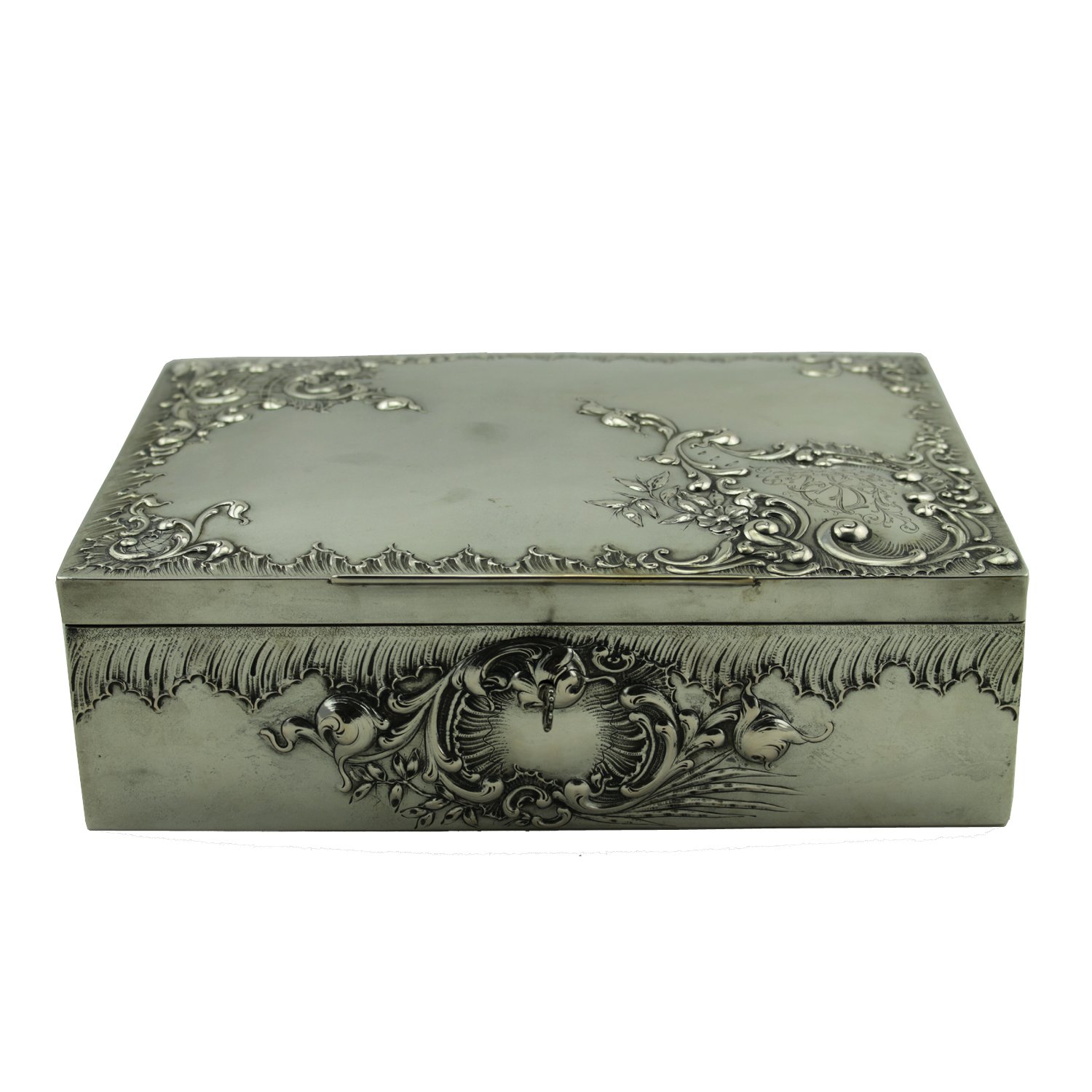Second Week of Advent Gift Guide
Welcome to the second week of Advent, the joyful Scandinavian Christmas tradition. We have finished decorating the gallery with our latest acquisitions and Christmas Calendar Exhibition and it looks stunning. This week’s Advent Gift Guide features a selection of treasures for everyone on your holiday shopping list as well as a stunning new painting titled “Grandma’s Glasses” by the well-known American artist Harry Roseland. Enjoy!
Gifts for Her
This exquisite object is known as a sewing clamp, or sewing bird, and first appeared in the 18th century and was commonly used throughout the 19th century. Acting as another hand to firmly hold pieces of fabric in place so that the sewers had both hands free to manoeuvre the fabric or stitches as needed, the pin cushion on top also helped to keep needed pins at arm's reach. As most clothing was produced by hand, these clamps where cherished and were often given as gifts to young ladies for special occasions like weddings or birthdays. The decoration gradually became much more elaborate, taking on the shape of animals and including holders for thimbles, spools, and other sewing supplies. These birds or clamps continued in popularity until clothing manufacturing and the sewing machine made them obsolete.
To learn more about the history of candlesticks, read our blog post here.
Russell Smith (Kwakwaka'wakw (Kwakiulth) (Canadian) 1950-2011), Orca Pendant, Silver orca whale pendant, signed and dated on reverse "Russell Smith 75", Size in inches: 2.5 h x 2.25 w
SOLD
Gifts for Him
Copper hunting horn with nickel stem and mouth piece, stamped P. Howden West Norfolk, 1851/1862, and Kohler & Son Makers (from Covent Garden) 185 Piccadilly London, English circa 1905, Size in inches: 9 h x 1.5 w x 1.5 d
SOLD
Pierre-Jules Mêne was one of the most influential artists of the French Animalier school. He exhibited almost every year for over 30 years at the Salon from 1838 until his death in 1871. He was so influential that his works were accepted posthumously at the Salon for 8 years after his death. Read more about the artist here.
French repeater carriage clock, with elaborate white metal dial, marked on movement "E.M & Co French Make" and numbered "2247", retailed by Russells Ltd. Paris. The maker, E Maurice & Co, are recorded as working at Rue Charlot 75, Paris and showed carriage clocks at the 1889 Paris Exposition. Late 19th century. Complete with two keys. Size: 6.25 h x 3.25 w x 3 d
SOLD
For the horologist on your list, this brass carriage clock is of outstanding design and workmanship and perfect for any desk, shelf or mantle. Carriage clocks or “officers’ clocks” as they are sometimes known, were first developed for Napoleon Bonaparte between 1798 and 1812 by Abraham-Louis Breguet. The clock cases are simple in form for ease of transport and are usually made of plain or gilt brass in a rectangular shape with a carrying handle and inset with glass, or on occasion enamel or porcelain panels. The balance spring used to drive the clock replaced the pendulum needed in earlier larger bracket clocks. These small spring-driven clocks were designed for travelling and sometimes came encased in leather or leather-covered wood cases which would protect the clock in transport. It is rare today to find the clock and leather cover intact as time has often deteriorated the leather or the clock and cover have become separated over time. In the past carriage clocks were a traditional gift to retiring or long-serving staff.
Modern brass school bell with turned wooden handle, 20th century, Size in inches: 10 ½ x 5 ¾
SOLD
Gifts for the Tea Lover
The history of tea dates back almost 5,000 years to ancient China. In the 17th and most of the 18th century, tea was extremely expensive and supplied in a rather crude form with large leaves and a great deal of dust. The drinking of tea became a status symbol, and at first the domain of royalty and women. Tea was kept in locked containers or tea caddies, often with internal lids or canisters. Often the caddy would have a bowl used for mixing the tea, although there is some speculation as to whether this was used for sugar. Several accompanying implements were developed including the mote spoon, which was used to sift and strain tea, as well as to clear the spout of the teapot. Even with modern advancements of current day tea production mote spoons can still be used for their original purpose, and the intricate designs and rich history make them an excellent gift for any collector with a love for antiques or the narrative of tea. Originally cups were simple with a matching saucer and the addition of a handle was introduced by the designer Robert Adams, who also introduced the creamer and sugar to the tea and coffee set to cater to the British taste. Today a good cup of tea is a worldwide ritual as a welcome break from work, a moment alone or shared with a friend.
Chinese tea strainer with decorated rim depicting dragons, late 19th century, Size in inches: 1 h x 5 ½ w x 3 ¾ d
SOLD
This is the perfect gift for any tea lover. Not only are tea strainers immensely collectible, they are practical and easy to use with any loose leaf tea. This example is particularly beautiful with the ornate decoration depicting dragons and a lotus flower.
When purchasing a tea caddy or box, always keep an eye on quality and attention to detail used in construction. Royalty and nobility often enlisted skilled craftsmen to create stunning examples incorporating rare materials including tortoiseshell and exotic hardwoods such as walnut, rosewood, and fruitwood, often adorned with gold, silver, or horn. Craftsmanship on a level almost extinct today has made these pieces last through the centuries. Some have been altered for practical uses such as for holding jewellery, however those with original hardware, interiors and locks with keys remain the most desirable. These popular and collectible objets d’art are a joy to live with and something to pass on to future generations.
Gifts for the Gourmand
Antique solid brass apothecary mortar and pestle, European, late18th/early 19th century, Size in inches: 5.5 h x 7 w (length of pestle: 9.75)
SOLD
The mortar and pestle is a vital tool which has remained unchanged in design for more than 10,000 years. In the kitchen, laboratory, or pharmacy, the mortar and pestle is a staple for wet or dry materials. They have been made from various materials throughout the years, including stone, porcelain, and wood. However, for the best practical use, the material cannot be too brittle or permeable by wet ingredients so as not to contaminate whatever is being prepared. One of the most useful tools in any kitchen, modern foodies still find this an indispensable tool for crushing spices and grinding ingredients into a powder. This solid brass pestle was most likely used by an apothecary to prepare medicine, but for today’s kitchen use is perfect for preparing pesto, etc. It is a lovely example and comes from a wonderful collection we recently purchased.
English sterling silver muffineer or shaker with removable pierced top, sitting on square base, Sheffield 1907, maker Joseph Rodgers and Sons, Size in inches: 7.25 h x 2.37 w x 2.37 d
SOLD
George II Rococo baluster shaped sterling silver coffee pot on circular foot, chased decoration to the body and cover with flowers, scrolls and scaling, scroll-capped wooden handle and fluted spout terminating in a bird's head, London maker Thomas Whipham, date mark most likely 1740, Size in inches: 9 ¾ h x 8 ¼ w x 4 ¾ d
Featured Work
This charming depiction of a young girl knitting wearing her grandmother’s glasses is aptly titled. We placed the painting many years ago and so enjoy getting these treasures back to find a new home.
The well known American artist Harry Roseland specialised in African American themes and these paintings brought him immediate critical and financial success. His genre scenes were widely accepted as authentic studies of the life of impoverished post-civil war Southern African Americans. Today works by Harry Roseland are found in many notable collections, including the collection of Oprah Winfrey, as well as in many American museums.






























